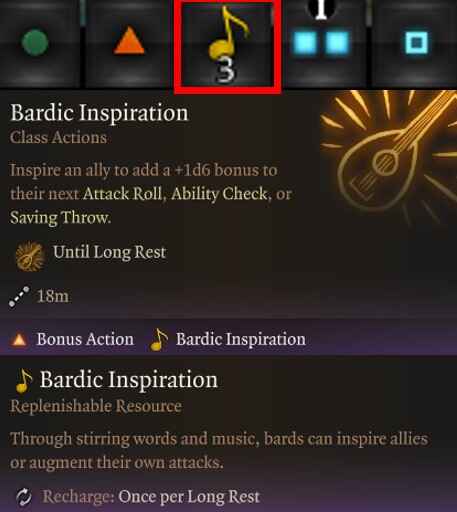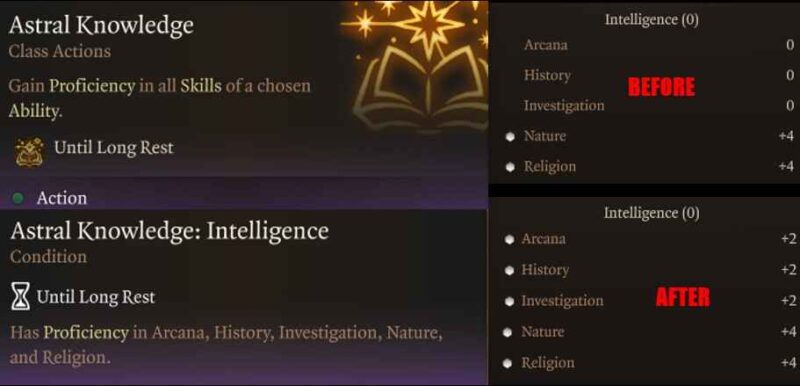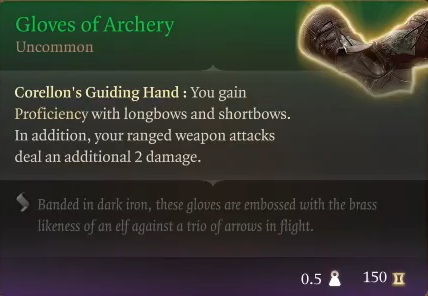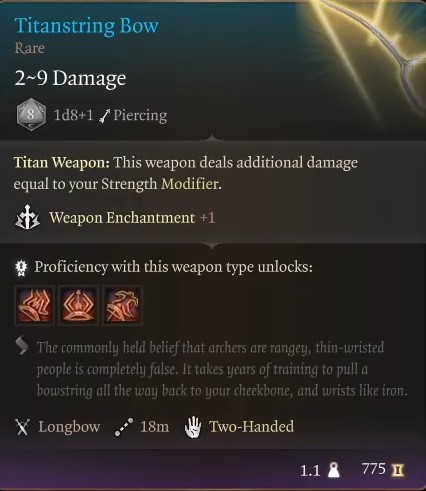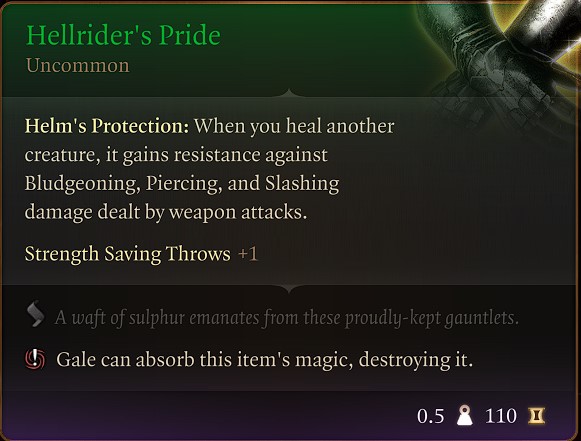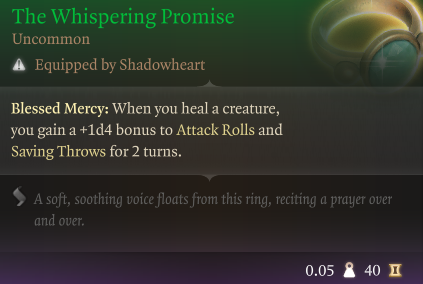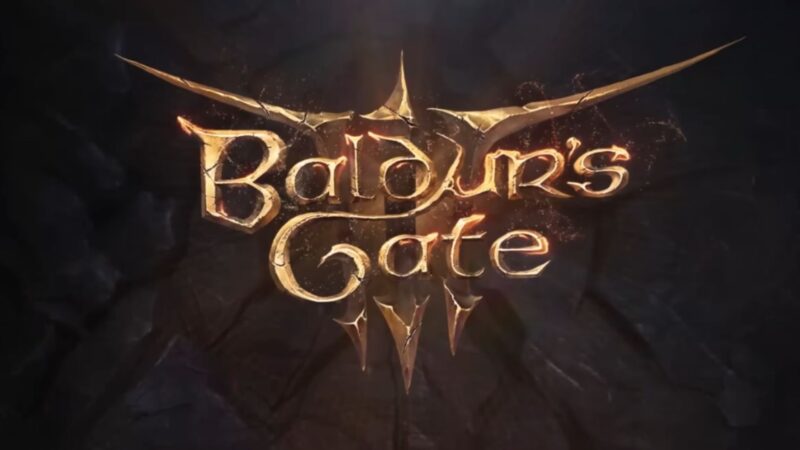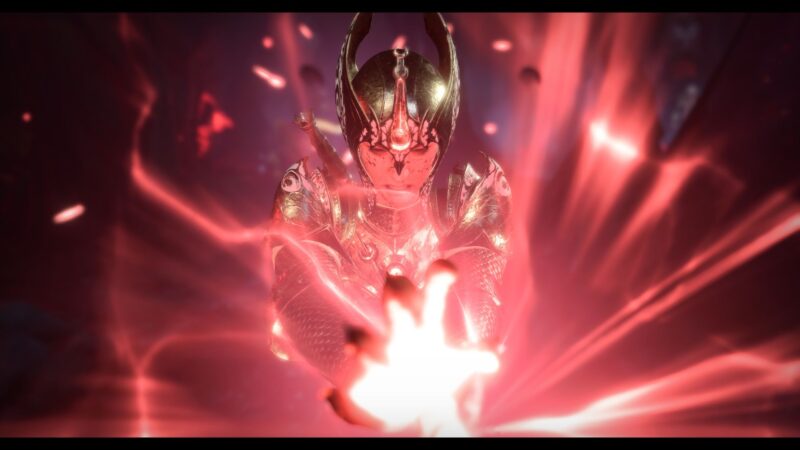Baldur’s Gate 3 is a complex and challenging game for starting characters and builds, and we’ve compiled a list of 10 to help beginner or returning players.
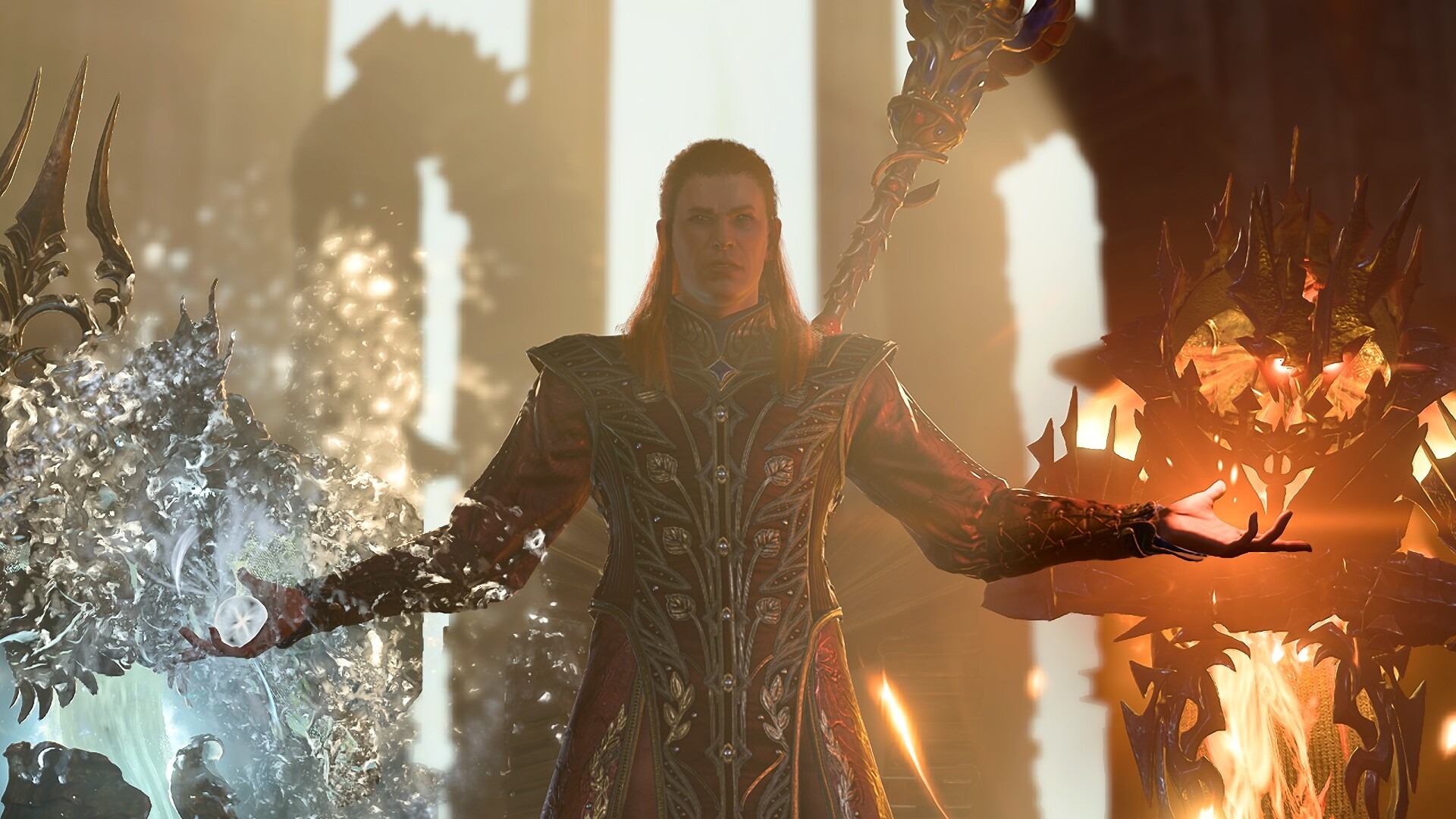
In Baldur’s Gate 3, beginner builds include a set of players’ choices at character creation and during leveling progression. Race, ability score, skills, spells, and more, BG3 uses the Dungeons and Dragons’ 5e modified rule set. Thus, you must factor in armor, weapon proficiency, and combat and exploration bonuses. We’ve aimed to simplify this process, giving you 10 powerful builds regardless of your experience level and leveling progression suggestions. We cover feats, spells, cantrips, and gear in this beginner’s build guide for Baldur’s Gate 3.
What should your character build focus on in BG3? A Beginners Guide
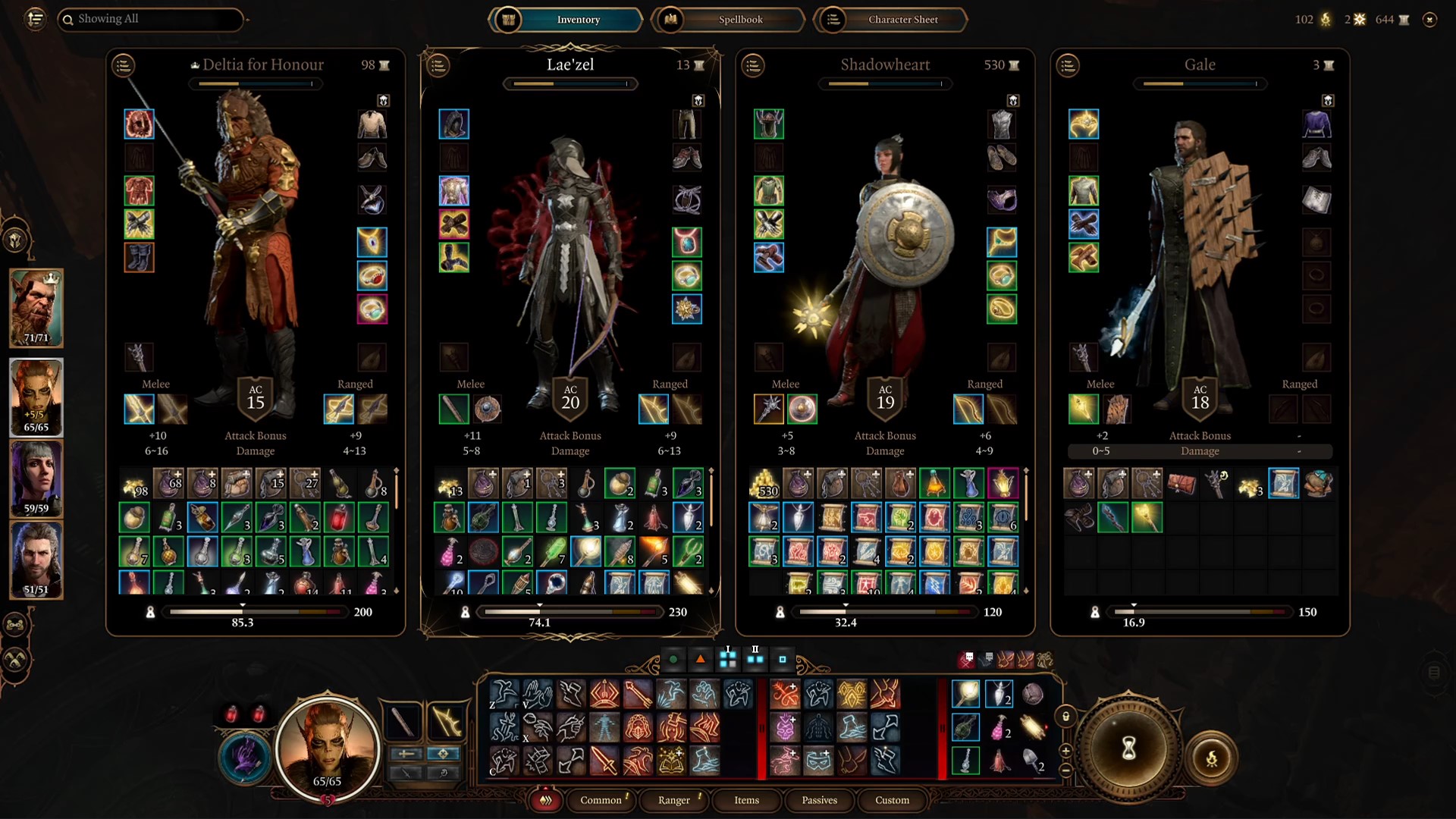
A beginner character in BG3 should focus on unlocking your subclass and reaching level 5 as soon as possible by completing the side quest and the main story. At level 3, your character will likely have a subclass that unlocks new and powerful features. Moreover, at level 5, most builds and classes see a massive spike in power due to features like Extra Attack and level 3 spells (fireball). Prioritize collecting materials, stockpiling gold, arrows, and consumables, and exploring early on. Familiar yourself with the map and do every side quest possible to gain experience and increase levels. You can always respec using Wither’s, so don’t be afraid to make a mistake!
If you’re unfamiliar with the DnD 5e rule set or armor proficiency, selecting something like a Fighter or Ranger with a straightforward combat style is a great choice. Additionally, spell slots requiring replenishment via a long rest can be frustrating, and forgoing the use of spells due to lacking spell slots. However, classes like the Warlock can bypass this annoyance with short rest refreshing spell slots. Speaking of spells, the area damage in BG3 includes “friendly fire.” This can destroy your entire party with a fireball meant for a golbin. However, the Evocation Wizard has a unique subclass feature that prevents AOE-friendly fire.
Our top 10 list compiles the best builds for beginners based on your goals. BG3 has added Honour Mode difficulty and custom game options to fine-tune your experience. This list will showcase some of the best builds for beginners in combat and exploration.
Related:
10 Best Starting Character Builds For Beginners in BG3
The best beginner builds in Baldur’s Gate 3 contain simplistic combat mechanics, ease of exploration, and bonuses with dialogue. The most effective build for combat is the Ranger, which stays at range, shooting arrows with Titanstring Bow + Club of Hill Giant Strength. This gear combination, arrows, and extra attack produces the most damage possible at level 5. For simplicity, nothing beats a Battle Master Fighter build, using heavy armor and a Greatsword, which focuses on melee attacks with little complexity. Lastly, the Druid Shapeshifter is extrondarily powerful at early levels because you can heal, support, and use the Wild Shape form to gain an extra health bar.
Below are our recommended best beginner builds in Baldur’s Gate 3:
- Ranger: the most dominant build for combat performance due to item sets and range.
- Fighter: the easiest to understand and extremely effective early (Lae’zel companion).
- Druid: with healing, support, and an extra health bar from Wild Shape, Druid’s are awesome for beginners.
- Cleric: The Cleric shines in utility, and the Life subclass helps heal your allies.
- Sorlock: using multiclassing early on combines the best of the Sorcerer and the Warlock.
- Wizard: the best build for area damage without friendly fire.
- Rogue: when you need to sneak or lockpick, you gotta have a Rogue (Astarion).
- Monk: The Monk doesn’t require fancy weapons or armor, using clothing and unarmed attacks.
- Barbarian: Similar to the Fighter, Barbarians use clothing with huge health and have tons of gear sets made for them in Act 1.
- Bard: Simply put, it is the best for influencing conversations and controlling dialogue.
10. Bard Persuasion
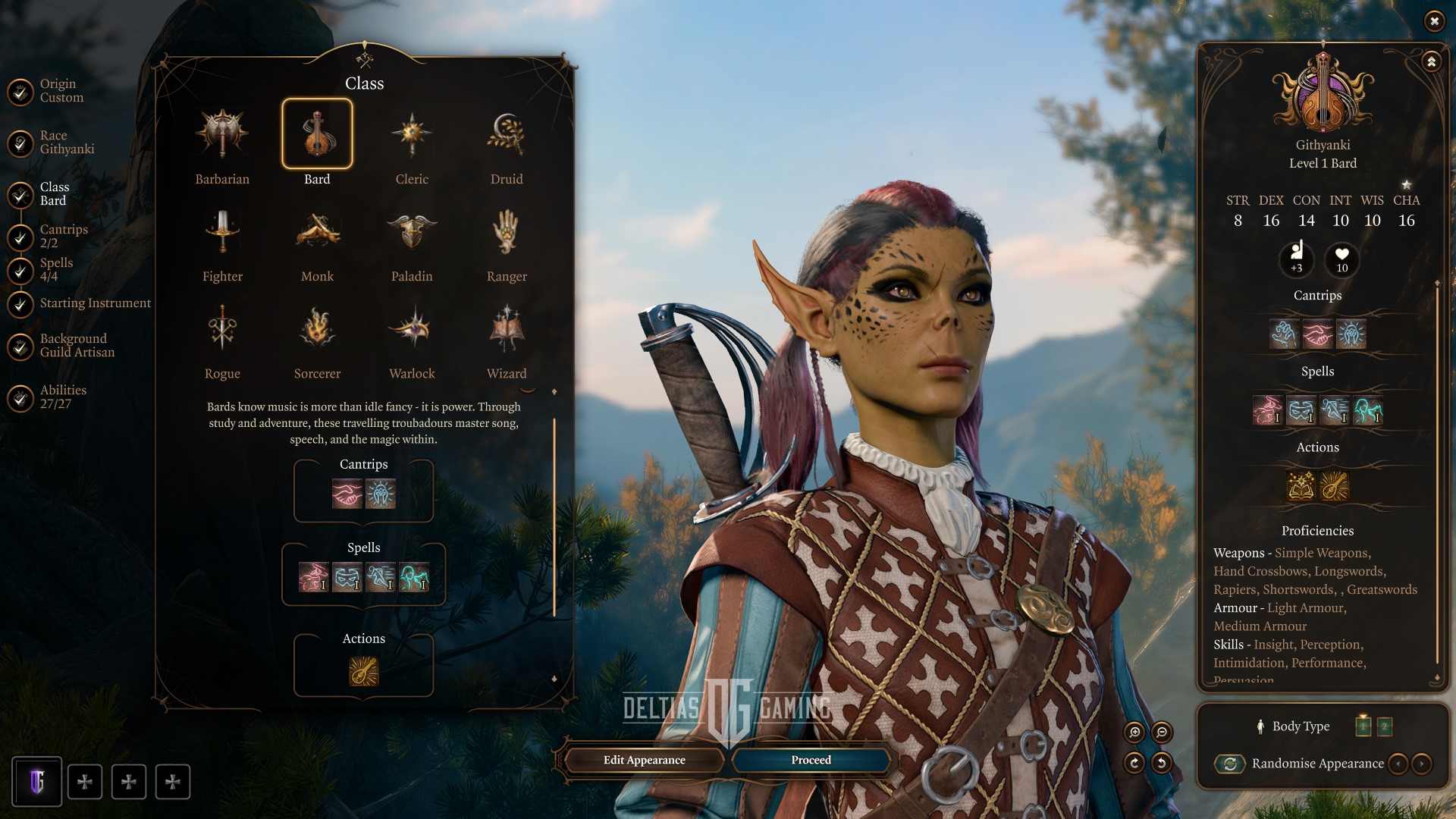
The Bard Persuasion build is the master at influencing dialogue and persuading (or intimidating) NPCs. Moreover, the Bard has access to many utility spells and crowd control, which are useful early on. The best beginner Bard build in Baldur’s Gate 3 uses a Githyanki race, the College of Valour subclass, and two dual-hand crossbow weapons. The dual-crossbow setup can give you extra bonus attack usage when attacking with two weapons and range. Moreover, you can use one hand and shield with College of Valour at level 3, boosting your Armour Class (AC) by +2. This helps avoid attacks, and combining a shield with 16 Dexterity in medium armor will put you at 17 without spells.
Bardic Inspiration helps allies with ability checks, attack rolls, and saving throws. You can use this inside or outside of combat to influence checks. Moreover, astral knowledge boosts your skill proficiency in one area, giving you an automatic +2 for all skills in the category. This is helpful if you don’t have a Wizard who uses intelligence in your party composition. Thus, you can have one character with proficiency or expertise in nearly all skills. Simply put, this gives you one character to explore and interact with NPCs, having a high likelihood of passing all checks.
Subclass: College of Valour
Armor: Medium
Weapons: 2x Hand Crossbows
Race: Githyanki
Ability Score
- Strength – 8
- Dexterity – 16
- Constitution – 14
- Intelligence – 10
- Wisdom – 10
- Charisma – 16
Level Progression
- Level 1 – Bardic Inspiration
- Level 2 – Tasha’s Hideous Laughter
- Level 3 – Combat Inspiration
- Level 4 – Feat Sharpshooter
- Level 5 – Invisibility
- Level 6 – Extra Attack
- Level 7 – Freedom of Movement
- Level 8 – +2 Dexterity
- Level 9 – Seeming
- Level 10 – Conjure Elemental, Counterspell
- Level 11 – Fighter Multi-Class
- Level 12 – Action Surge
9. Barbarian High Health
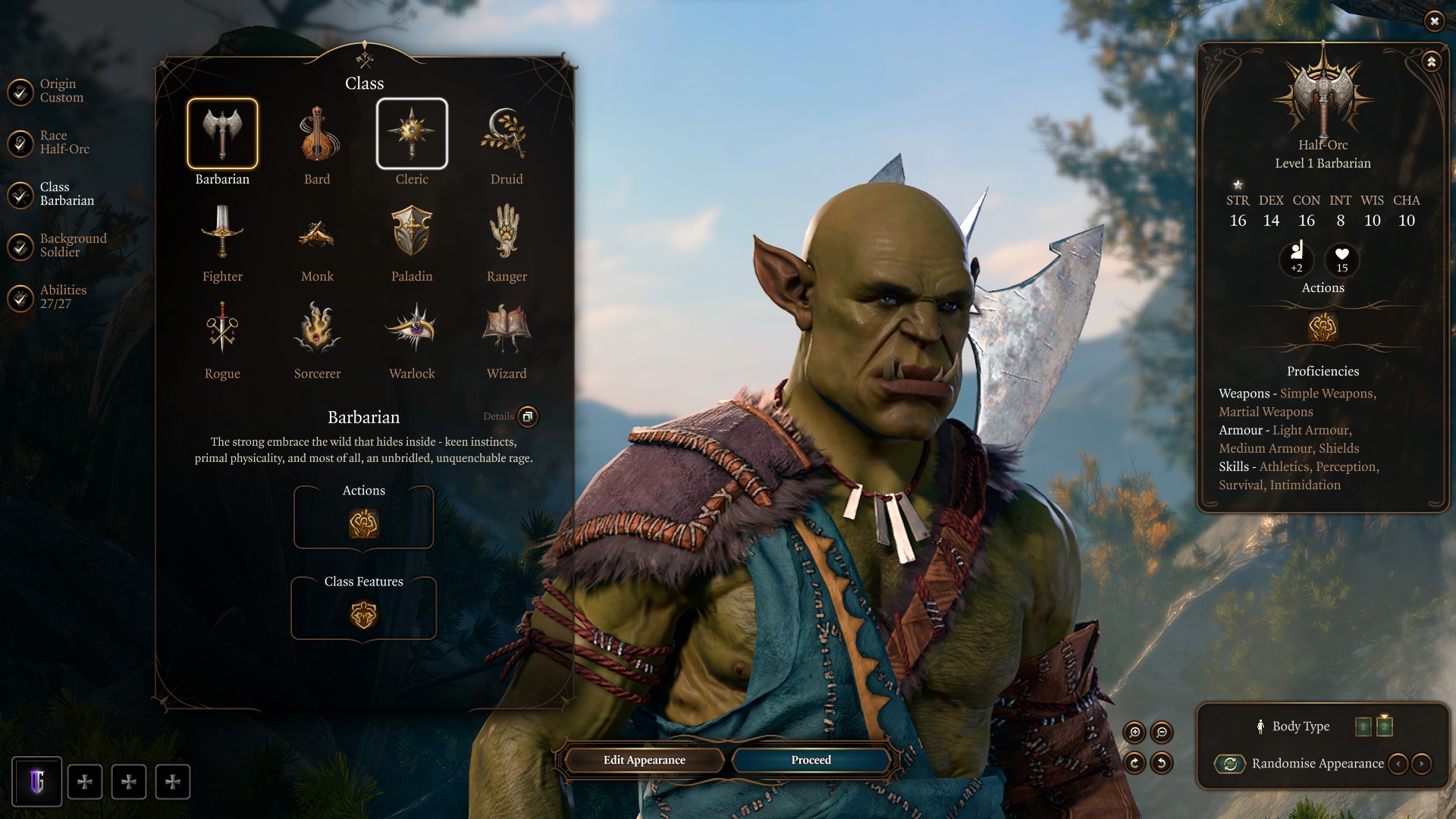
The Barbarian High Health build in Baldur’s Gate 3 is the true meathead, with incentives to take damage in melee combat. Unlike the Fighter, the Barbarian gains a Rage and Unarmoured Defence mechanic. Rage gives both damage resistance and increased melee damage and throws damage. At level 3, you can take the Berserker subclass, which allows you to throw items in your inventory, stunning enemies and doing big damage. This gives you a great advantage early, tossing junk for a ranged stun while maintaining high HP.
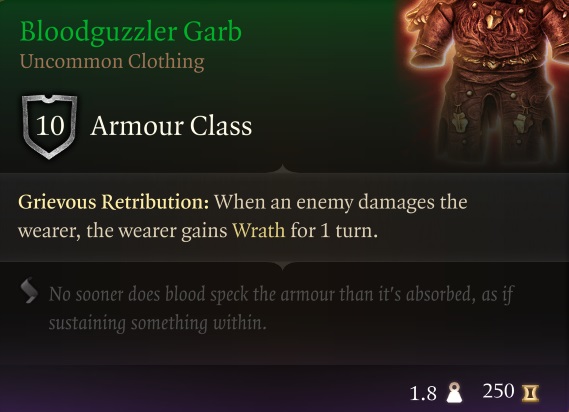
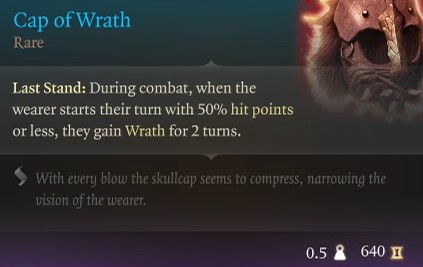

Larian Studios loaded up gear sets in Act 1 for the Barbarian, and players should look to collect Bloodguzzler Garb, Cap of Wrath, and Linebreaker Boots. Your build should emphasize strength and melee aggression. Stock up on Hill Giant Strength Elixirs and use them after a long rest to increase strength and take the Great Weapon Master feat at level 4. Now, you have two ways to attack with your bonus action, including a range stun, giving you increased utility. However, the Fighter is still more straightforward and has more armor proficiencies, but the Barbarian is a great alternative.
Subclass
- Berserker (Barbarian)
- Thief (Rogue)
- Champion (Fighter)
Armor: Cloth
Weapons: Greatsword
Background: Soldier
Race: Half-Orc
Ability Score
- Strength – 16
- Dexterity – 14
- Constitution – 16
- Intelligence – 8
- Wisdom – 10
- Charisma – 10
Level Progression
- Level 1 – Rage & Unarmored Defense
- Level 2 – Reckless Attack
- Level 3 – Berserker Subclass
- Level 4 – Great Weapon Master
- Level 5 – Extra Attack
- Level 6 – Multiclass Rogue
- Level 7 – Cunning Action
- Level 8 – Thief Subclass
- Level 9 – +2 Strength
- Level 10 – Multiclass Fighter
- Level 11 – Action Surge
- Level 12 – Champion Subclass
8. Monk Unarmed
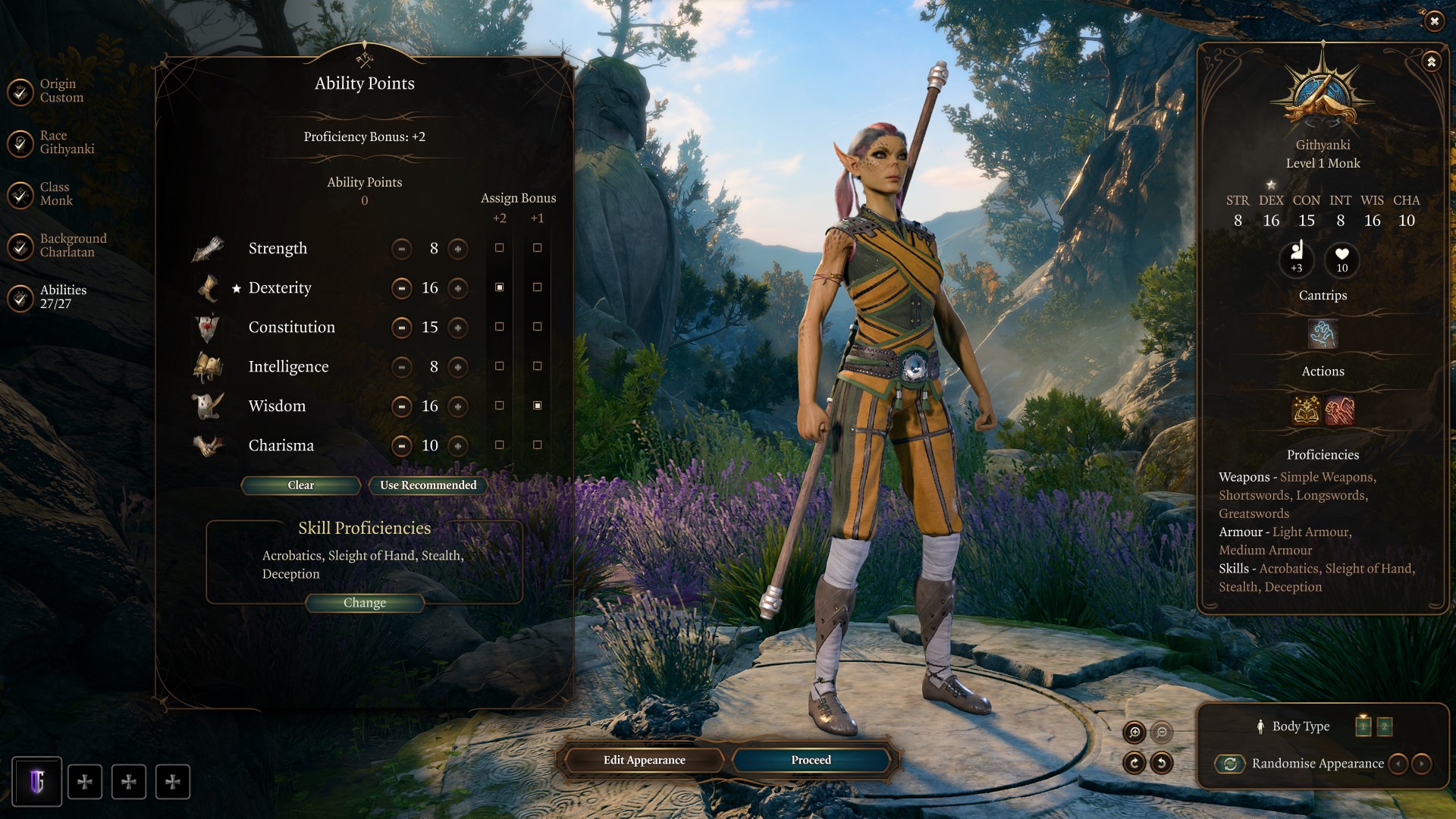
The Monk Unarmed build is an excellent alternative for beginners because it doesn’t require gear sets or weapons to be powerful. With a Monk, your damage comes from gloves, not weapons, which you will find a bunch of Monk-specific gear in Act 1 (Armour of Uninhibited Kushigo, Gloves of Cinder and Sizzle, and Cap of Wrath). The downside of this build is that you gain your subclass at level 3, which can be annoying for the first two levels. However, the build shines early in the game after you gain Way of the Open Hand and the Tavern Brawler feat at level four.
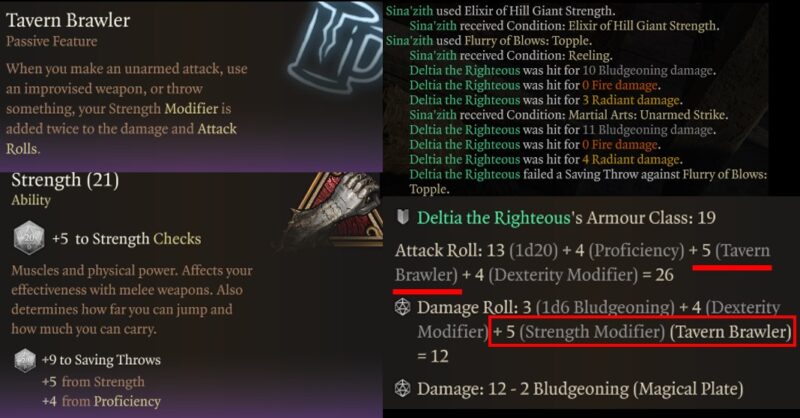
At level 5, you gain an extra attack as a Monk, giving you two attacks per action. With the Tavern Brawler feat selected at level 4, you gain damage based on your strength modifier. While this seems complex, you lower your strength to 8 in character creation. Lower strength seems counterintuitive, but you can use an elixir of hill giant strength to automatically boost your strength to 21 until a long rest. Therefore, you gain a +5 for EVERY attack with the Monk! You then multiclass to a Rogue, gaining an extra bonus action, giving you endless attacks, especially early in the game.
Subclasses
- Way of Open Hand (Monk)
- Thief (Rogue)
- Fighter (no subclass)
Armor: Clothing
Weapon: Unarmed
Background: Charlatan
Race: Githyanki
Abilities Score
- Strength – 8
- Dexterity – 16
- Constitution – 15
- Intelligence – 8
- Wisdom – 16
- Charisma – 10
Level Progression
- Level 1 – Flurry of Blows
- Level 2 – Unarmoured Movement
- Level 3 – Way of the Open Hand Subclass
- Level 4 – Tavern Brawler Feat
- Level 5 – Extra Attack
- Level 6 – Ki Empowered Strikes
- Level 7 – Multiclass to Rogue
- Level 8 – Cunning Actions
- Level 9 – Additional Bonus Action
- Level 10 – Alert Feat
- Level 11 – Multiclass Fighter
- Level 12 – Action Surge
7. Rogue Utility
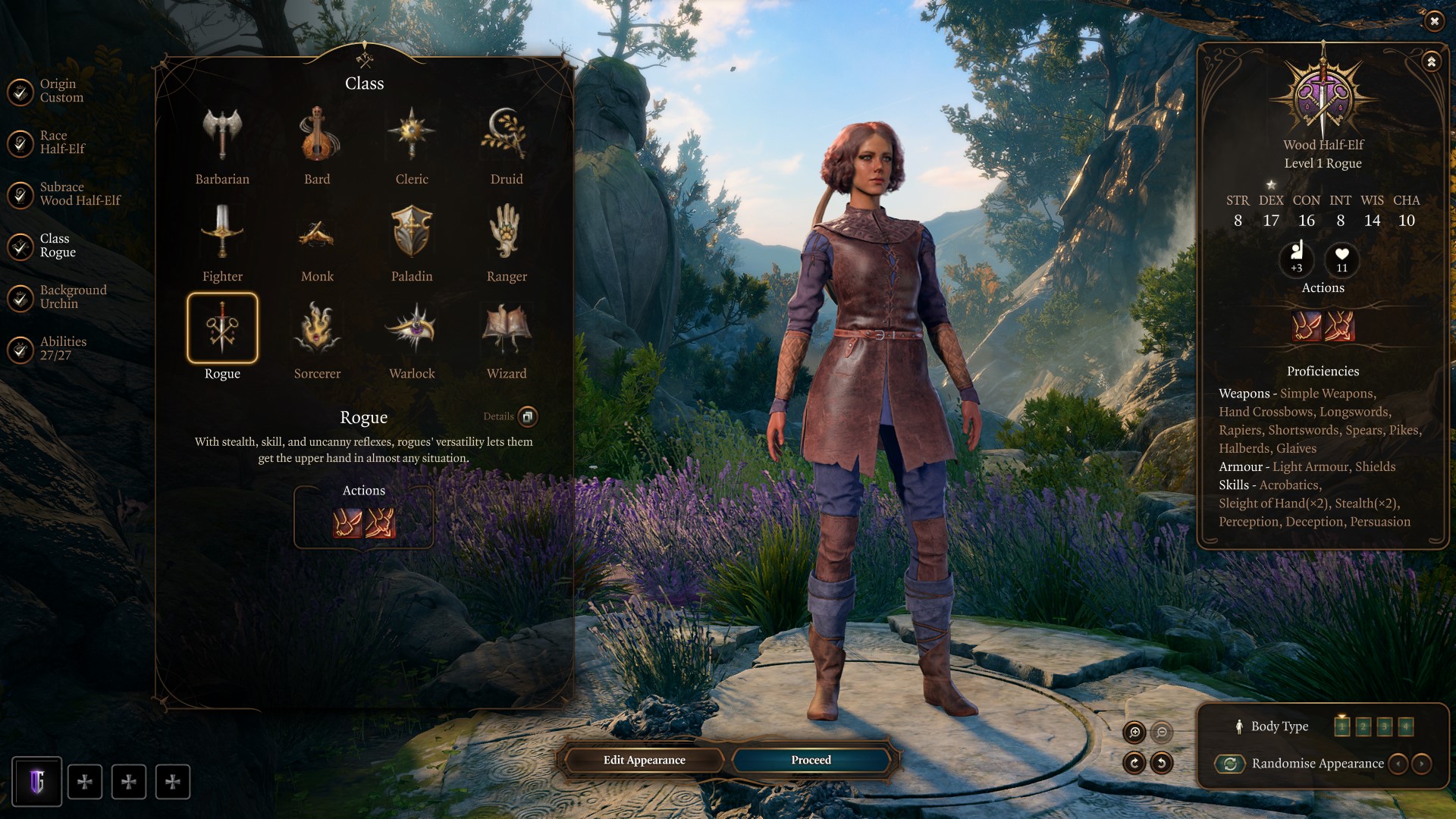
The best part about the Rogue Utility build for beginners is you gain utility to open your chest, sneak, and steal! The downside to the Rogue is that your combat power is severely weak unless you are multiclass. Most Rogues use the sneak attack feature to play dual wield in melee range. However, this can be punishing for beginners playing in dangerous proximity to enemies. Therefore, look to gain the Gloves of Archery and Titanstring Bow. Gloves of Archery solves the biggest issue for Act 1 Rogue’s lack of Longbow Profienceny.
Early on, your character will play similarly to a Ranger, staying at a distance and shooting down targets. Furthermore, take advantage of the stealth skill by starting combat from stealth, undetected, to trigger the surprise status effect. The surprise status effect can give your party a free round of combat while the enemy is surprised. Therefore, we suggest using a Rogue in your party, especially if you like the Astarion companion.
Subclass: Thief (Rogue), Battle Master (Fighter), Gloom Stalker (Ranger)
Armor: Light
Weapons: Longbow
Background: Urchin
Race: Wood Half-Elf
Ability Score
- Strength – 8
- Dexterity – 17
- Constitution – 16
- Intelligence – 8
- Wisdom – 14
- Charisma – 10
Solo Rogue Level Progression
- Level 1 – Sneak Attack
- Level 2 – Cunning Actions
- Level 3 – Second Bonus Action
- Level 4 – Feat Sharpshooter
- Level 5 – Multiclass to Fighter
- Level 6 – Action Surge
- Level 7 – Battle Master Subclass
- Level 8 – Feat + Dexterity
- Level 9 – Extra Attack
- Level 10 – Multiclass to Ranger
- Level 11 – Spellcasting/Hunter’s Mark
- Level 12 – Gloom Stalker Subclass
6. Wizard AOE Damage

The strength of a Wizard AOE Damage build for beginners is your spells do not trigger friendly fire on allies or companions. Other spellcasters have to avoid placing large area circles down because it will possibly hit their allies. The Evocation subclass specifically avoids this, giving you a much easier time launching huge fireball damage spells as early as level 5!
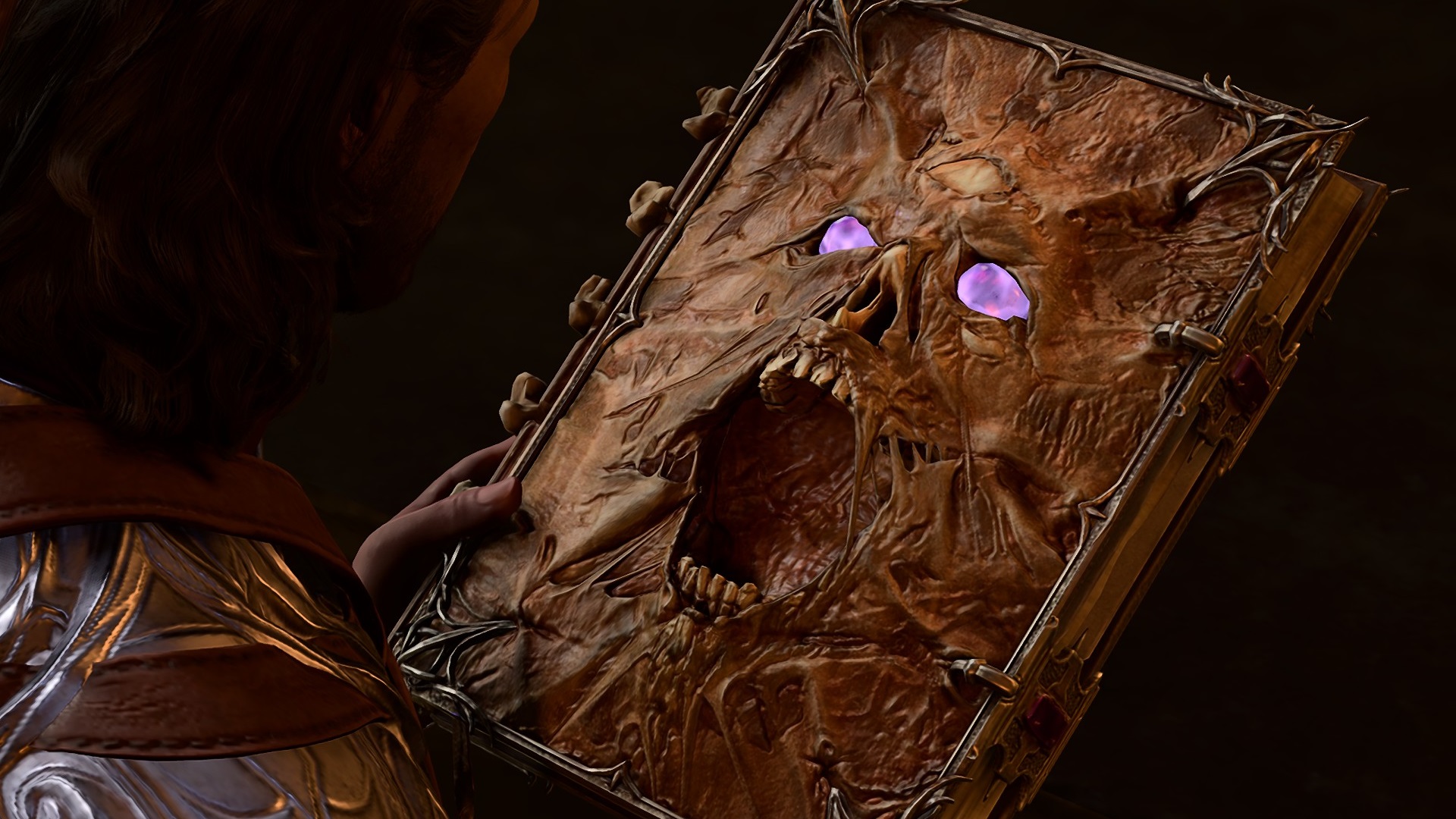
Another essential part of bringing a Wizard to your party is that they are the only class who’s intelligence ability score. This can help you unlock powerful permanent bonuses and make certain skill checks much more straightforward. Even if you don’t choose to play as a Wizard, having Gale join your party gives you a massive advantage throughout your campaign.
Subclass: Evocation School
Armor: Cloth
Weapons: Quarterstaff and Shield
Background: Sage
Race: High Half-Elf
Ability Score
- Strength 8
- Dexterity 16
- Constitution 14
- Intelligence 16
- Wisdom 10
- Charisma 10
Level Progression
- Level 1 – Chromatic Orb Spell
- Level 2 – Find Familiar Spell
- Level 3 – Misty Step Spell
- Level 4 – Feat +2 Intelligence
- Level 5 – Fireball and Haste Spells
- Level 6 – Counterspell
- Level 7 – Ice Storm Spell
- Level 8 – Spell Sniper Feat
- Level 9 – Conjure Elemental Spell
- Level 10 – Cone of Cold Spell
- Level 11 – Disintegrate Spell
- Level 12 – Feat +2 Intelligence
5. Sorlock Multiclass
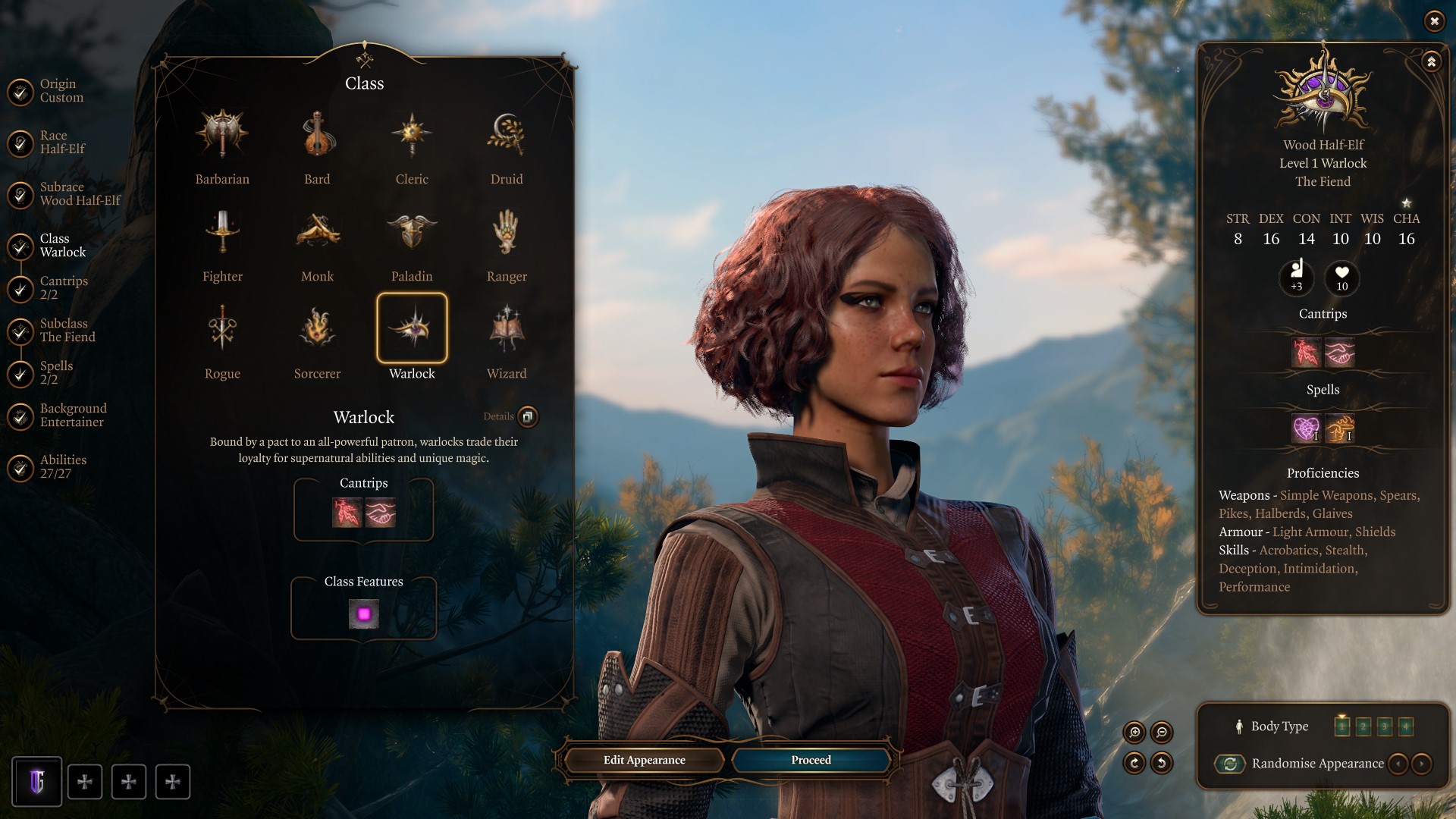
The strength of a Warlock for beginners is that its spell slots replenish after a short rest. Therefore, you don’t have to struggle to constantly hoard camp supplies or take time away from exploration to return to camp. However, the Warlock power fades in combat beyond level 5, so you should combine it with a Sorcerer. The Sorlock Multiclass build gains the easiest one-two combination of spells and cantrips in BG3 Hex + Eldritch Blast.
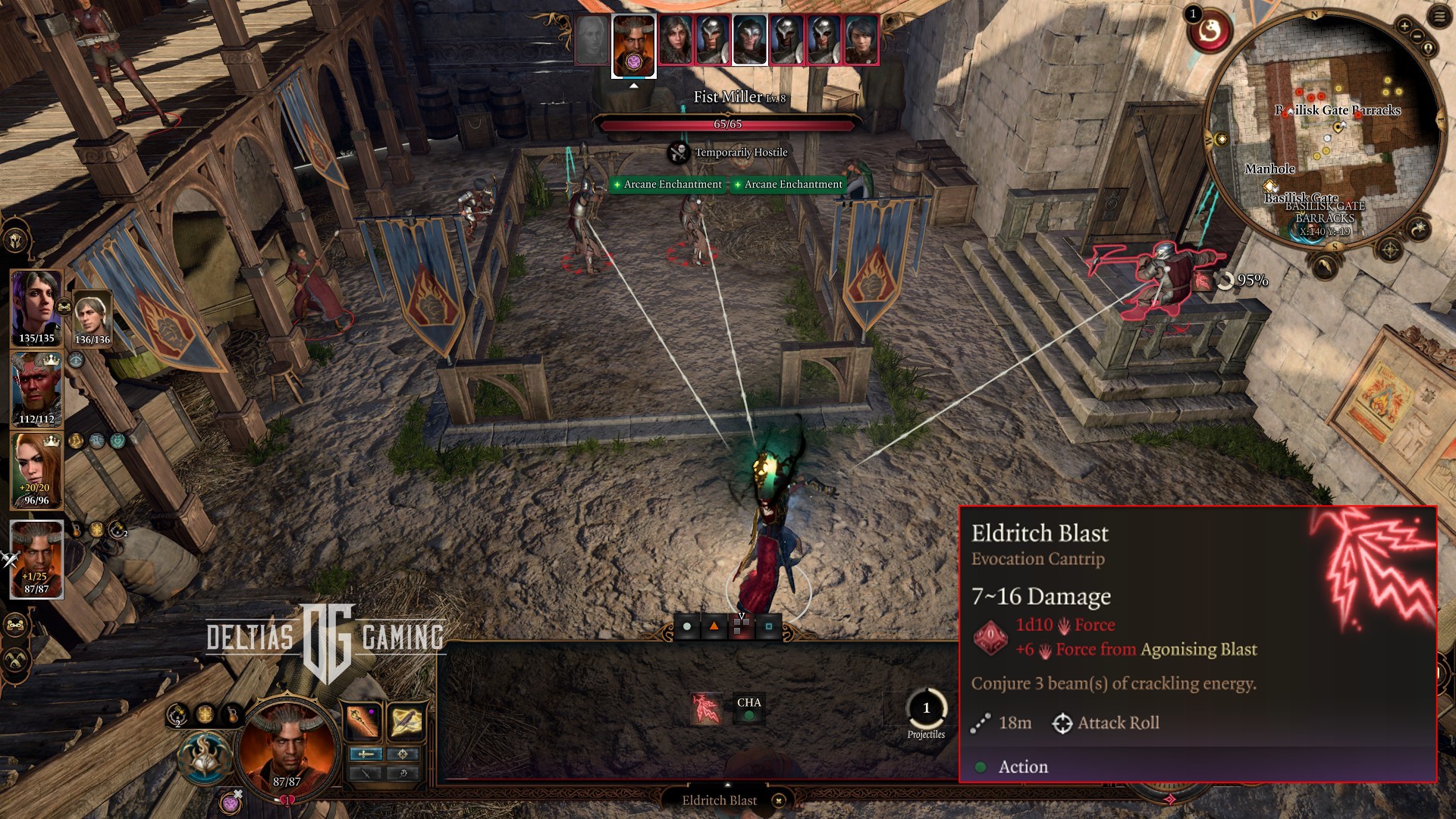
Hex is a debuff spell that triggers extra damage when hit. Eldritch Blast is the most potent cantrip in the game, and it doesn’t require a spell slot. You gain fantastic damage when used together without constantly using up spell slots. Then, you combine the Sorcerer’s spells to increase your combat effectiveness by gaining metamagic. Metamagic allows you to cast multiple spells per turn while retaining the cantrip combo, which makes Warlock a favorite among beginners.
Classes
- 4 Warlock
- 8 Sorcerer
Subclasses
- The Fiend
- Draconic Bloodline
Armor: Clothing
Weapons: Quarterstaff, Shield
Race: Wood Half-Elf
Ability Score
- Strength: 8
- Dexterity: 16
- Constitution: 14
- Intelligence: 10
- Wisdom: 10
- Charisma: 16
Sorlock Level Progression
- Level 1: Select Warlock Class
- Level 2: Agonizing and Repelling Blast
- Level 3: Pact of the Chain
- Level 4: Scorching Ray
- Level 5: Multiclass to Sorcerer
- Level 6: Twinned & Careful Metamagic
- Level 7: Quickened Metamagic
- Level 8: Shatter
- Level 9: Fireball
- Level 10: Counterspell
- Level 11: Ice Storm
- Level 12: Banishment
Feats
- +2 Charisma Levels 4, 8
- Spell Sniper Level 12
4. Cleric Healer
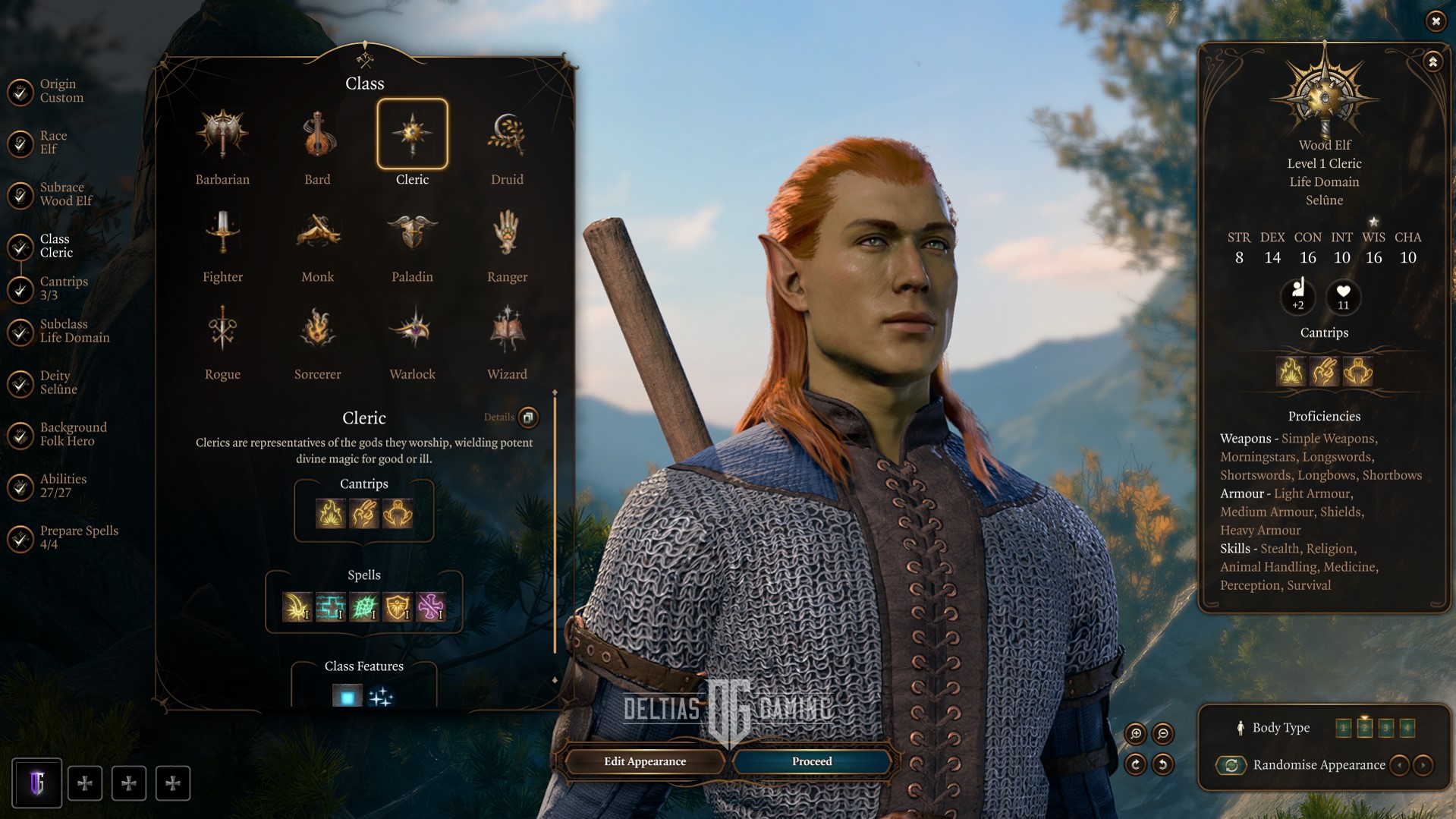
As a beginner, you are likely to take damage constantly and have a team with low health. This is where the Life domain Cleric Healer build excels at healing and group utility. You are not only limited to healing with a Cleric. Spells like Guiding Bolt and Sacred Flames cantrip do significant damage early and give you something to do every turn when your party is at max health. Moreover, you gain a spiritual weapon spell early, which creates a distraction summon NPC that hits harder than some of your allies at level 3.
Read More: Baldur’s Gate 3 Bard College of Valour Build
An overpowered combination in Act 1 with the Cleric healer is the two items: Hellrider’s Pride and The Whispering Promise. Using the spell healing word, you heal all allies in a wide radius around you. They will gain resistance (half damage) to bludgeoning, piercing, slashing, and the blessed bonus for two turns with these two items. This combination can be done early as a beginner with a bonus action, dramatically increasing your party’s survivability even on honor mode difficulty.
Subclass: Life Domain
Armor: Heavy
Weapons: One Hand & Shield
Race: Wood Elf
Background: Folk Hero
Ability Score
- Strength – 8
- Dexterity – 14
- Constitution – 16
- Intelligence – 10
- Wisdom – 16
- Charisma – 10
Level Progression
- Level 1 – Guiding Bolt Spell
- Level 2 – Turn Undead
- Level 3 – Spiritual Weapon
- Level 4 – Feat +2 Wisdom
- Level 5 – Mass Healing Word Spell
- Level 6 – Glyph of Warding Spell
- Level 7 – Guardian of Faith Spell
- Level 8 – War Caster Feat
- Level 9 – Flame Strike Spell
- Level 10 – Planar Binding Spell
- Level 11 – Planar Ally
- Level 12 – Feat +2 Wisdom
3. Druid Shapeshifter
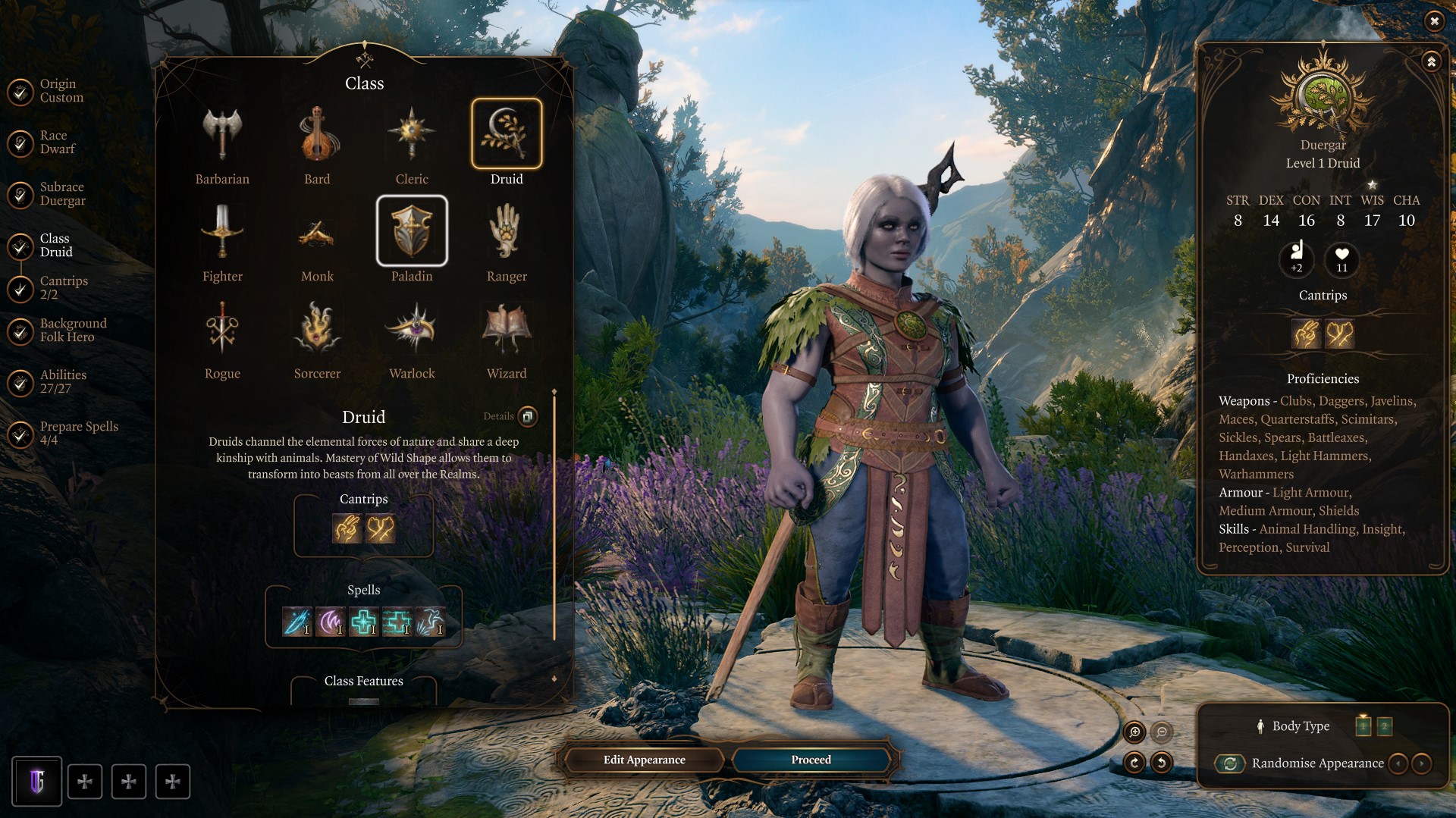
The Druid Wild Shape build for beginners gives you an extra health bar when you transform into a creature. Unlocked at level 2, the Circle of the Moon subclass can shapeshift using a bonus action and gains a heal while in wild shape form. This is helpful because you can cast a spell and transform it into a wild shape within the same turn. Early on, using a spell to heal, stun, or summon a creature can be the difference between a wipe or a win.
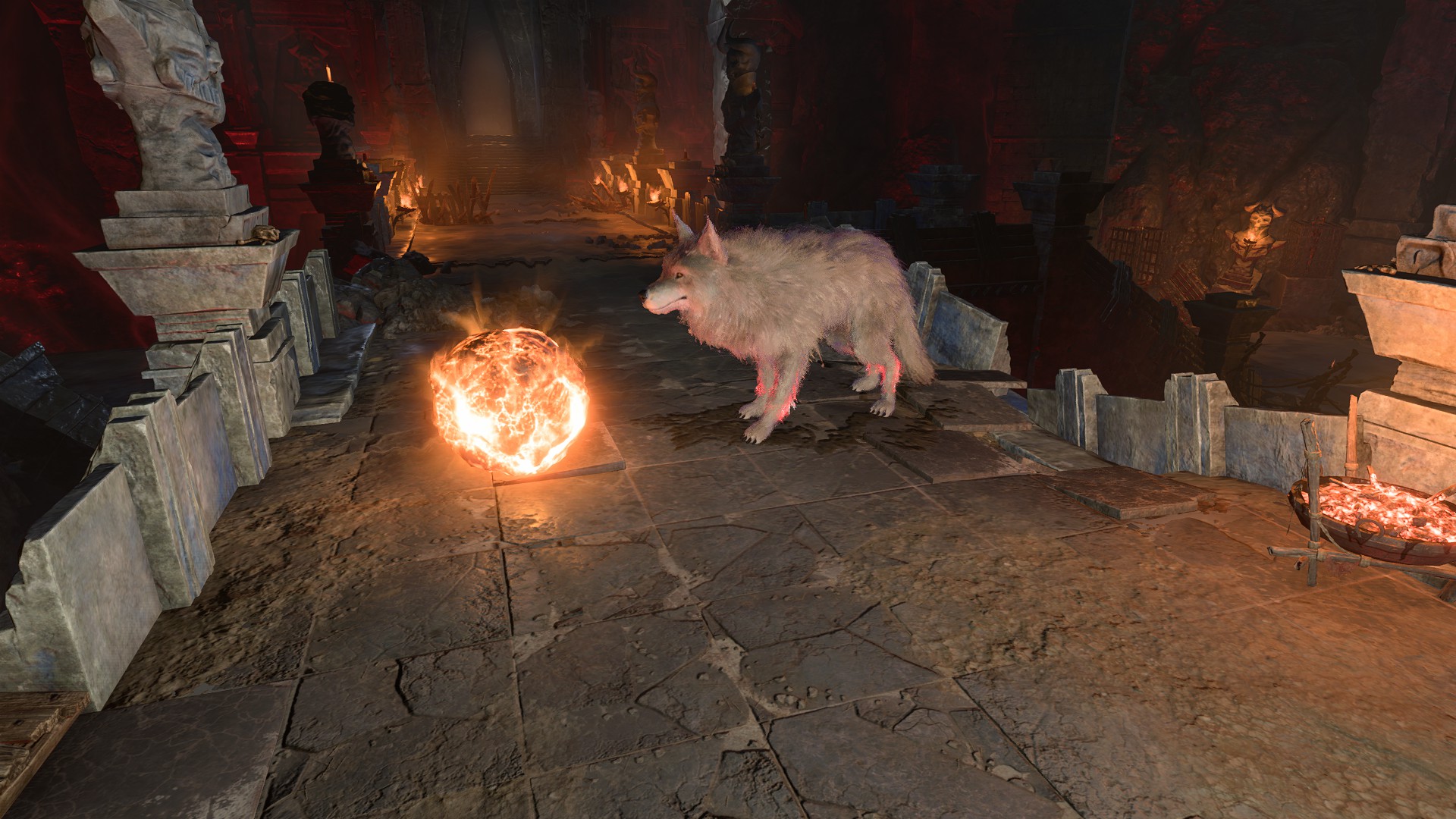
The best combination early on is using the Flame Sphere spell at level 3 while transforming into a Wolf. The sphere will give you another controllable NPC, and the Wolf form will allow you to do damage and gain another bar of health. Using the Duergar Dwarf race gives you an enlarged spell at level 3. This can be pre-cast outside of combat and doesn’t require concentration, boosting advantage on strength checks and saving throws. If you’re frustrated with dying early on in BG3, try a Druid and Shape Shift to gain a huge bar of HP, especially the Owl Bear!
Read More: Baldur’s Gate 3 Shadow Magic Sorcerer Build
Subclass: Circle of the Moon
Armor:
- Medium in Acts 1 & 2
- Light in Act 3
Weapons: One Hand & Shield
Background: Folk Hero
Race – Duergar Dwarf
Ability Score
- Strength – 8
- Dexterity – 14
- Constitution – 16
- Intelligence – 8
- Wisdom – 17
- Charisma – 10
Solo Druid Level Progression
- Level 1 – Ice Knife
- Level 2 – Moon Subclass
- Level 3 – Flaming Sphere Spell
- Level 4 – War Caster
- Level 5 – Sleet Storm
- Level 6 – Plant Growth
- Level 7 – Conjure Woodland Being
- Level 8 – Alert Feat
- Level 9 – Conjure Elemental
- Level 10 – Ice Storm
- Level 11 – Heroes’ Feast
- Level 12 – Confusion
2. Fighter Melee DPS
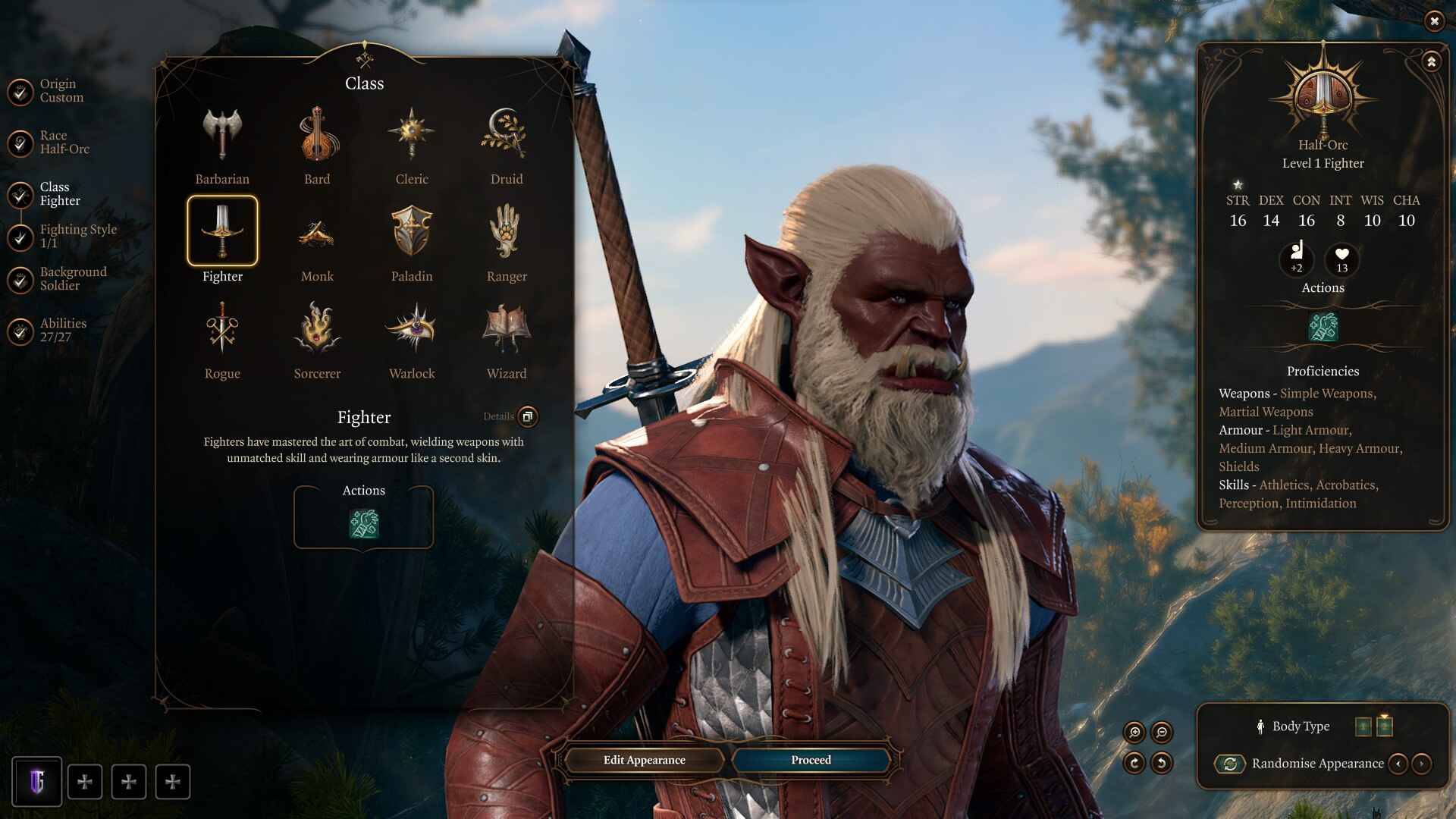
What if you learned there was a build capable of 14 attacks per turn (look below), which had high survivability and was easy to play? That is the Fighter Build and is our second best for a beginner because of its simplicity in gameplay. What separates the Fighter from other builds is it doesn’t need to multiclass, cast complex spells, or obtain fancy gear to do incredible damage in combat. You are the only class that gains extra attack and improves extra attack and action surge. Thus allowing the most attacks in a single turn in BG3.
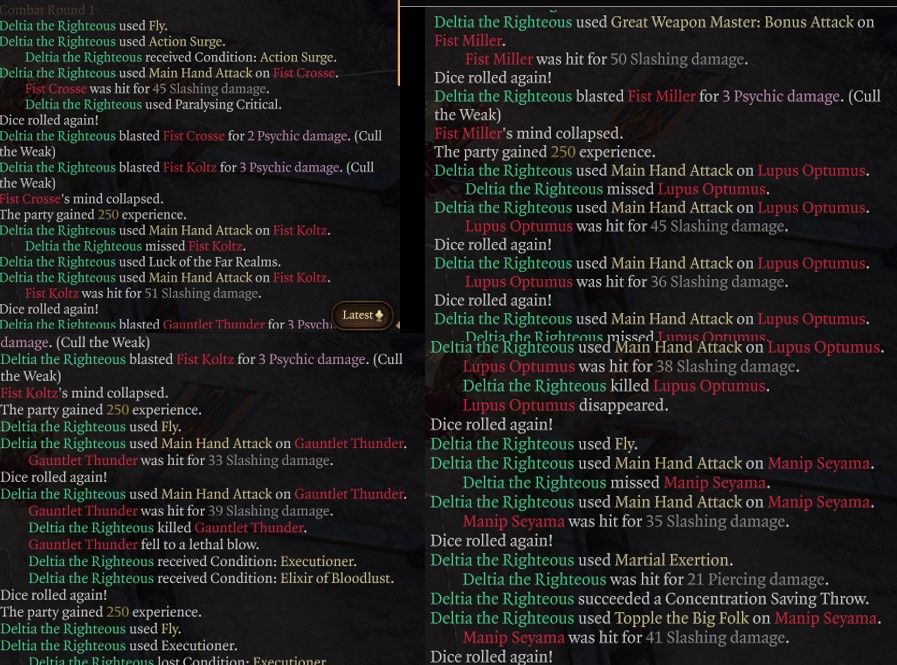
Since the Fighter can equip any armor or weapon, look to grab the Adamantine Splint Armour, Disintegrating Night Walkers, and Sword of Justice in Act 1. The reason we don’t rank the Fighter number one is that it lacks mobility and utility outside of combat. It’s a perfect class to play or bring in your party if you need a brawler who can pummel enemies in melee range.
Subclass: Battle Master (Fighter)
Armor: Heavy
Weapon: Greatsword
Background: Soldier
- Strength – 16
- Dexterity – 14
- Constitution – 16
- Intelligence – 8
- Wisdom – 10
- Charisma – 10
Level Progression
- Level 1 – Great Weapon Fighting
- Level 2 – Action Surge
- Level 3 – Battle Master Subclass
- Level 4 – Alert Feat
- Level 5 – Extra Attack
- Level 6 – Great Weapon Master feat
- Level 7 – Riposte, Precision Attack
- Level 8 – +2 Strength Feat
- Level 9 – Indomitable
- Level 10 – Sweeping Attack
- Level 11 – Improved Extra Attack
- Level 12 – +2 Strength Feat
1. Ranger Combat Domination

The Ranger is the best build for a beginner in Baldur’s Gate 3 because of its range damage, gear sets, spell casting, survivability, and utility. The Ranger is a better Rogue with slightly less utility at the start but dramatically increased combat effectiveness. Select the Dark Urge origin character for an overpowered build early, which will give you the Deathstalker Mantle Cloak. You gain invisibility on kills while equipped. Now, combine the Titanstring Bow with the Club of Hill Giant Strength and the Adamantine Shield with Graceful Cloth, and you have 20 Dexterity and 20 AC. This build is so powerful it can solo the entire game on honor mode difficulty.

If that weren’t enough, at level 8, you can buy arrows of many targets. You combine this with Oil of Combustion and a Fire or Smokepowder Arrow for incredible AOE damage rivaling a Wizard. Overall, this is the strongest build for a beginner or end-game player. The Ranger only lacks utility, which is made up for when you multiclass it with a Wizard.
Classes: Ranger, Rogue, Fighter
Subclasses: Gloom Stalker, Thief, Champion
Armor: Medium
Weapons: Longbow
Race: Wood Elf
Ability Score
- Strength – 8
- Dexterity – 17
- Constitution – 16
- Intelligence – 8
- Wisdom – 14
- Charisma – 10
Level Progression
- Level 1 – 17 Dex, 16 Con, 14 Wis
- Level 2 – Longstrider, Hunter’s Mark
- Level 3 – Gloom Stalker Subclass
- Level 4 – Sharpshooter
- Level 5 – Extra Attack
- Level 6 – Multiclass to Rogue
- Level 7 – Sneak Attack
- Level 8 – Fast Hands
- Level 9 – +2 Dexterity
- Level 10 – Multiclass to Fighter
- Level 11 – Action Surge
- Level 12 – Champion Subclass
FAQs about Beginner Character Builds in BG3
Q. What is the best character to start with in BG3?
Ans. The best character build in Baldur’s Gate 3 is a Ranger or FIghter. The Ranger allows you to play at range, cast spells, and equip almost any weapon or armor, having high survivability and damage. The Fighter is the most straightforward combat style that doesn’t require multiclassing or complex combat gameplay, though it lacks spellcasting and utility.
Q. What is the best starting setup in Baldur’s Gate 3?
Ans. The Gloom Stalker Ranger playing as a Githyanki race is the best starting setup in Baldur’s Gate 3. With this combination, you get unmatched turn-one utility and high initiative, so you almost always go first, damage and survivability. The Githyanki race gives you great bonuses and a unique story and dialogue that you would never see otherwise.
Q. What should I do first in BG3?
Ans. The most important thing to do in Baldur’s Gate 3 is complete the tutorial and recruit all the companions to your camp. Once this is done, spend time to unlock Wither’s and respec your companions to optimal roles and builds. The best overall setup is Melee Paladin (Charisma), Range DPS Wizard (Intelligence), Range DPS Ranger (Dexterity), and Healer Cleric (Wisdom).
Q. What is the easiest class to play in Baldur’s Gate 3?
Ans. The Fighter is widely considered to be the easiest class to play in BG3.
Looking For More About Baldur’s Gate 3?
Thank you for reading Beginner builds Baldur’s Gate 3 Guide. We provide the latest news and create guides for Baldur’s Gate 3. Also, watch me play games on Twitch or visit my YouTube channel!
 Reddit
Reddit
 Email
Email
